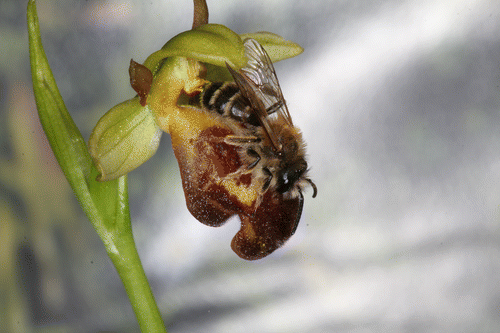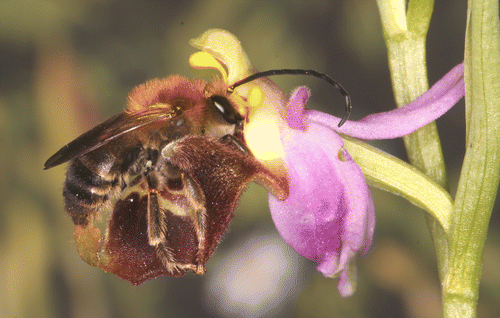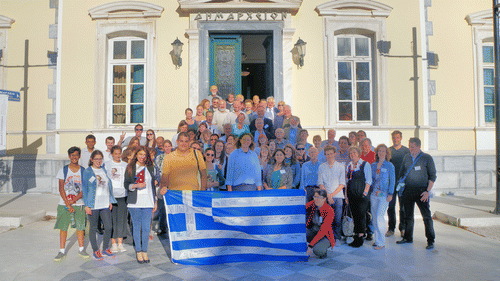The International Conference about Temperate Orchids Research and Conservation (TORC’15) was held on the island of Samos, Greece, from 14 to 18 April 2015. It was organized by the Sails-For-Science Foundation (a non-profit organization based in Germany, promoting a sustainable balance between nature and society for small island communities worldwide) under a sponsorship by the Société Botanique de France and several other societies. In this issue, we publish three papers spanning from this international meeting.
Figure 3. Field trip Andrena gravida on Ophrys pelinaea, Samos, Iraeon. © Hannes F. Paulus, University of Vienna. Reproduced by permission of Hannes F. Paulus. Permission to reuse must be obtained from the rightsholder.

Figure 4. Field trip Eucera punctulata on Ophrys samiotissa, Samos, Iraeon. © Hannes F. Paulus, University of Vienna. Reproduced by permission of Hannes F. Paulus. Permission to reuse must be obtained from the rightsholder.

The plant family Orchidaceae emerged on our planet 112 million years ago branching out to over 25,000 species with compatible populations of dazzling diversity comprising almost 8% of all vascular plants, unlike any other plant family (Pridgeon et al. 2001–2014). Their resilience to extremes reaches from tropical abundance to remote places in high latitudes and from sea level to high altitudes into the upper limit of continuous vegetation, with colonization of outstanding niches such as epiphytic habitats or heterotrophic nutrition in forests (Givnish et al. Citation2015). Moreover, they display tight interactions, sometimes mutualistic, sometimes parasitic, with their associated pollinators and mycorrhizal fungi (Selosse Citation2014). Why did this angiosperm family become so dominant during the race for the tree of life? What innovative mechanisms, behaviours and physiological processes have made its conquest so successful?
Although a number of intriguing phenomena of the orchid life cycle, relating to mycorrhiza, pollination, epiphytism, crassulacean acid metabolism (CAM), among others, has been unveiled, vast gaps in understanding of this success story of ecology and evolution remain.
(A) On the molecular level, what are the physiological modes of action of the orchid plant itself and its choices for a thriving environment in respect to the geochemical, microbiota, embryophyta, insect and herbivore cross-signalling?
(B) On the ecological level, what networks of co-evolutionary processes and which implications from abiotic change alter the homeostasis of orchid populations? Land abandonment for economic reasons and global climate change are the assumed main factors for the change or even the irretrievable decline of orchid biodiversity (e.g. Robbirt et al. Citation2014). The greatest challenge facing anybody interested in these charismatic plants is the vanishing of valuable orchid species in human-sculpted landscapes (Swarts, and Dixon Citation2009). Europe has now less than 1% land remaining in intact wilderness vegetation (Gillespie Citation2013). In Australia alone, 25% of the global orchid biodiversity has disappeared. Valuable secondary metabolites of orchids providing original potentials as therapeutics may be lost forever.
(C) Therefore, the application of orchid research for their conservation needs to become mainstream. Only concerted interdisciplinary research and the involvement of the general public, starting with the orchid enthusiasts, all united by the passion for this family of flowers, may deepen our understanding.
The aim of this conference was to provide a stimulating forum to this diverse group of people and to address the above-mentioned cornerstones (A), (B) and (C). Botanists, biologists, conservationists, chemists, ecologists, pharmacists, geneticists, orchidologists and others from more than 30 countries and five continents gathered on Samos contributing cutting edge science in seven sessions: (i) updates on the Greek and world orchid flora, (ii) systematics and population genetics, (iii) mycorrhizal studies, (iv) pollination, floral deception and reproductive success, (v) ethnobotany and propagation, (vi) population dynamics and determinants, and (vii) conservation. The island of Samos is embedded in an archipelago in close proximity to Minor Asia. These biogeographic conditions of the island sustain a high number of orchid taxa, especially in the genus Ophrys (see list below). The conference included extensive field trips to the charismatic flora during the blooming season on the island. Successful conferences are judged by their outcomes. The stimulating and convivial surroundings strengthened existing collaborations, and started a number of new research and conservation initiatives around the globe. To name a few examples, the establishment of an urgently needed European orchid conservation centre is being pursued, building on the experiences and in coordination with other continental conservation centres such as the North American Orchid Conservation Center. The closely interrelated orchid populations of the Aegean and Minor Asia are subject to immense habitat destruction, particularly through the unsustainable production of the traditional salep. In consequence of this conference, several research and conservation organizations from Greece, Germany and Turkey formed a consortium and formulated an international orchid conservation programme with the support of the IUCN Orchid Specialist Group. Moreover, Sails for Science, together with a Greek and Turkish institution, is in the final phase of closing a 15 month orchid conservation grant based on a EU-Turkey grant as a direct output from the conference. Also manifold international cooperations among researchers for so far dimly charted temperate orchid territories, as for example in Siberian Russia, Nepal, North Africa and South America, were concluded.
A most encouraging aspect of TORC’15 was the strong active participation by the next generation of orchid scientists with highly competent presentations and debates. Outstanding scientific achievements of young scientists from Chile, Germany and Greece, were awarded distinguished prizes sponsored by the Hellenic Society for the Protection of Nature and the New Phytologist Trust. One can be truly optimistic that going forward, orchid science and conservation are in good hands to meet the future challenges. Last but not least, the success of the meeting was enhanced by the involvement and the hard work of the local team of volunteers from Samos and elsewhere.
Finally, the meeting also produced a series of papers that will be disseminated by journals such as European Journal of Environmental Sciences, Journal Europäischer Orchideen, New Phytologist and Acta Botanica Gallica: Botany Letters. The present issue contains three of these papers on temperate orchids submitted after TORC’15. Two focus on the diversity of Mediterranean orchids: Vela and Viglione (Citation2015: 271–285) establish the checklist of the 51 orchid species and subspecies of the Lebanese flora, including 14 regionally endemic taxa; Vela, Martin and Ouni (Citation2015: 255–261) describe a new Tunisian species, Ophrys pseudomigoutiana, from populations hitherto wrongly considered as belonging to the Algerian species Ophrys migoutiana. In Northern Europe (Estonia), Metsare et al. (Citation2015: 263–269) analyse methods for estimating fitness from seed set in cheating Orchis militaris and in rewarding Platanthera bifolia, showing that seed number or seed abortion rate alone cannot be proxies for reproductive output. We wish that, together with the other papers and discussions from TORC’15, they will initiate and support further researches on orchids, that will always be welcomed by Acta Botanica Gallica: Botany Letters.
Table 1. Species and subspecies of terrestrial orchids native to the Island of Samos, Greece.
Notes on contributors
Sven Wagner, organizer of TORC’15, is Director of the Sails-For-Science Foundation, Germany.
Elisabeth Dodinet, is Editor in Chief of Acta Botanica Gallica: Botany Letters.
Marc-André Selosse, is President of the Société botanique de France, and works at the Institut de Systématique, Évolution, Biodiversité, the Muséum national d’Histoire naturelle, and the Sorbonne Université.
References
- Gillespie, A. 2013. Conservation, Biodiversity and International Law. Chaltenham, UK: Edward Elgar Publishing Limited.
- Givnish, T. J., D. Spalink, M. Ames, S. P. Lyo, S. J. Hunter, A. Zuluaga, W. J. D. Iles, et al. 2015. “Orchid phylogenomics and multiple drivers of their extraordinary diversification.” Proceedings of the Royal Society B 282 (1814): 20151553.
- Metsare, M., A. Ilves, M. Haldna, T. Kull and K. Tali. 2015. Four seed quality measures in orchids with different pollination systems. Acta Botanica Gallica: Botany Letters 162 (4): 263–269.
- Pridgeon, A.M., P.J. Cribb, M.W. Chase, and F.N. Rasmussen. 2001–2014. Genera Orchidacearum, vol. 1–6. New York, NY: Oxford University Press.
- Robbirt, K. M., D. L. Roberts, M. J. Hutchings, and A. J. Davy. 2014. “Potential disruption of pollination in a sexually deceptive orchid by climatic change.” Current Biology 24: 1–5.
- Selosse, M.-A. 2014. “The latest news from biological interactions in orchids: in love, head to toe.” New Phytologist 202: 337–340.
- Swarts, N. D., and K. W. Dixon. 2009. “Terrestial orchid conservation in the age of extinction.” Annals of Botany 104 (3): 543–556.
- Vela, E., R. Martin, and R. Ouni. 2015. Ophrys pseudomigoutiana (Orchidaceae), a new species from Tunisia. Acta Botanica Gallica: Botany Letters 162 (4): 255–261.
- Vela, E., and J. Viglione. 2015. Recent inputs to the Lebanese orchid flora and proposal of a national checklist for Orchidaceae family. Acta Botanica Gallica: Botany Letters 162 (4): 271–285.


